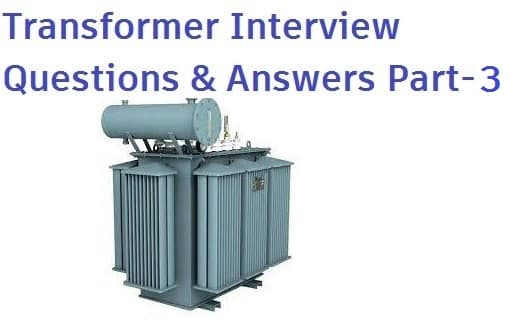What is the definition of Transformer? What is a transformer?
A transformer is a static piece of electrical equipment which transform the voltage from one level to another without altering the frequency. The power equation of the transformer is ;
Primary side power = Transformer losses + secondary side power
The transformer losses are negligible with respect to its input power, so this can be neglected and;
Primary side power = Secondary side Power
Vp Ip = Vs Is
What is working principle of transformer?
The transformer working is based on Faraday’s law of electromagnetic induction. The rate of change of flux in the primary induces voltage in the primary. The flux travels through the magnetic core and links to secondary winding. And, thus it produce voltage in the secondary winding. The mutual induction between the primary and secondary winding produce the voltage in primary and secondary.
What is rating of transformer?
Rating of any electrical equipment is its capability of producing rated output without temperature rise above its permissible limit. The current in the secondary of the transformer must not increase beyond its rated full load secondary current. Transformer rating is in kVA.
Why transformer rating is in kVA?
The magnitude of the secondary current depends on nature of the load. If the transformer is feeding to resistive load, the power factor is unity. But, if the transformer is delivering power to RL,RLC,RC circuit then the power factor can not be unity and always less than 1. The low power factor cause current to increase without increase in active power.
If transformer rating is in kW, it can supply to particular type of load. The manufacturer of the transformer does not know for which type of load consumer will use the transformer. Therefore, transformer rating is kVA.
I = P /(√3 V CosΦ )
I ∝ 1/ CosΦ
Thus secondary current is inversely proportional to the power factor. If transformer operates at lower power factor, it kVAr demands increase and to maintain the same kVA its active power delivery decrease.
How does the transformer power factor varies?
At no load, when transformer secondary is not connected to the load consumes magnetizing power for producing the flux. Thus, the power factor of the transformer is very low at no load.
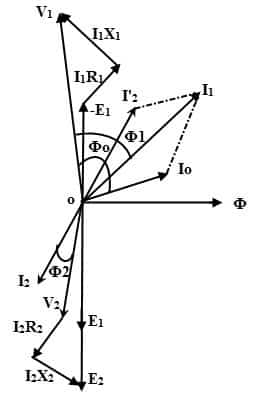
As load increase on the transformer, the power factor improves, and finally power factor of the transformer is almost equal to the load power factor. From above phasor diagram, it is clear that angle between the V1 and I1 decrease with increase in load.
What are the types of winding of transformer?
There are two types of winding.
- Primary winding
- Secondary winding
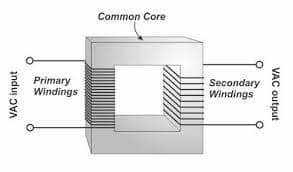
The primary winding is fed with AC supply. And, voltage induce in the secondary. The supply is taken out from the secondary of the transformer.
What is the Core of the transformer?
The function of the core to carry the magnetic flux. The reluctance of the core must be minimum for easy flowing of the flux through the transformer core. The lesser the reluctance , the lesser will be the hysteresis loss. The silicon steel has higher permanence. Therefore, CRGO steel core is used for transformers.
What is the permissible maximum flux density in transformer core?
The maximum flux density of the CRGO steel core is 1.6 to 1.8 Tesla. If flux density increase above 1.8 Tesla, the core is not able to carry the flux, and core heating may cause core insulation failure.
What is CRGO steel core?
CRGO is the abbreviation for Cold Rolled Grain Oriented Steel. The CRGO steel core is the best core material for transformers. CRGO steel has exceptionally magnetic properties in the rolling direction. During cold rolling the crystals of the steel arranged in the direction of grain formation in a specific direction.
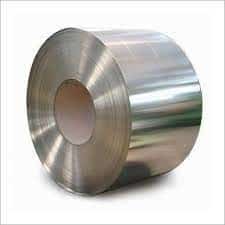
Thus, it becomes easy to magnetize the core. The hysteresis loss of the grain oriented silicon steel core is very less compared to non gain oriented silicon steel.
Why is the iron core laminated sheets used in transformer?
The eddy or circulating current flows in the core. And, this eddy current heats up the core. The magnitude of the eddy current should be as low as possible to reduce the heating in the core. The eddy current depends on the voltage produced in the core and the resistance of the core.
The resistance of thin laminated sheets is more than the solid core. The reason is that thin conductor has less cross section area and large resistance.
I = Voltage induced in the core / Resistance of core
The magnitude of the thin lamination higher, and because of this the current (I= V/R) is very less. The heat loss or eddy current loss(I2R) decreases drastically with use of thin laminated sheets.
What material is used for transformer core?
CRGO laminated steel is used for transformer core. The silicon is 4 to 5 % in the core. The silicon steel has the following properties.
- High magnetic permeability
- Low eddy current and hysteresis loss
- Low magnetostriction force
- High knee saturation characteristics.
How is magnetic leakage reduced?
The magnetic leakage reduces by;
- Reducing the magnetizing current to the minimum
- Minimizing the reluctance of the iron core to the minimum
- Reducing the number of primary and secondary turn to the minimum
- Sectionalizing and interleaving the primary and secondary winding
How does interleaving reduce magnetic leakage in a transformer?
Interleaving reduces the maximum flux swing of transformer core. Interleaving of winding are in layers like, primary-secondary-primary and more. Hence, it utilizes the maximum flux as magnetizing inductance and very less amount of flux leaks from the core.
In addition to this, it also reduces proximity effect as both carries opposite fluxes.
What is leakage flux in a transformer?
The flux which does not links to both primary and secondary winding is the leakage flux. The leakage flux is unutilized flux. There is some flux which links only with the primary coil, but not with the secondary coil is primary leakage flux, and it contributes to primary leakage reactance.
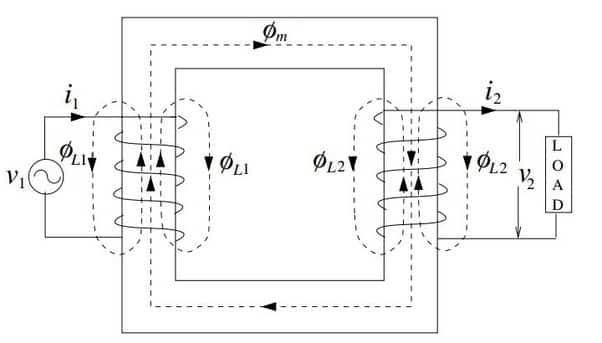
Likewise, there is some flux which links only with the secondary coil, but not with the primary coil is the secondary leakage flux, and it contributes to secondary leakage reactance.Both the leakage fluxes added together, amounts to total leakage flux.
Related Posts
